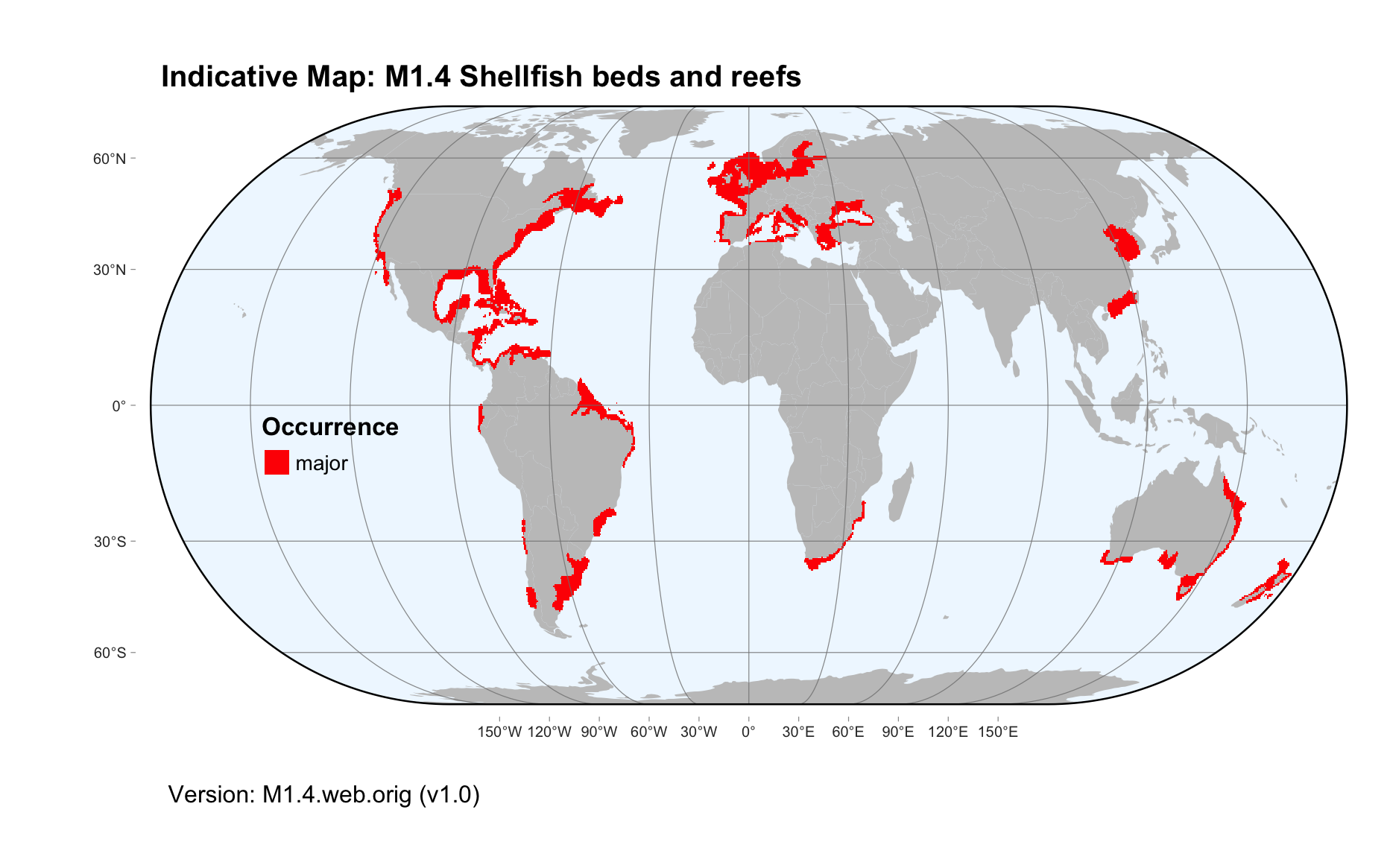Global ecosystem typology
Alternative site for the Global ecosystem typology with additional information for ecosystem profiles and indicative maps.
This site is maintained by jrfep
M1.4 Shellfish beds and reefs
Biome: M1. Marine shelf biome
Contributors:
(texts)
These productive intertidal or subtidal biogenic ecosystems are formed and dominated by sessile molluscs like mussels or oysters, around temperate or tropical coasts and estuaries globally. They filter plankton from the water column, acting as carbon sinks and modifying local physical environments by changing currents and dampening wave action. Distribution is limited by available rocky substrates on low-energy coastlines, as well as requirements for high water quality and oxygen availability. Many organisms are adapted to the extreme range of conditions typical of the intertidal zone (e.g. shellfish closing valves to avoid adverse desiccation).
Key Features
Intertidal or subtidal three-dimensional stuctures, formed primarily by oysters and mussels, and supporting algae, invertebrates and fishes..
Overview of distribution
Tropical to temperate estuarine and coastal waters.
Profile versions
- v1.0 (2020-01-20): MJ Bishop; DA Keith
- v2.0 (2020-06-15): MJ Bishop; SE Swearer; SN Porter; AH Altieri; DA Keith
- v2.01 ():
- v2.1 (2022-04-06): MJ Bishop; SE Swearer; SN Porter; AH Altieri; DA Keith Full profile available at official site
Main references
Selected references for this functional group:
Dame RF, Patten BC (1981) Analysis of energy flows in an intertidal oyster reef Marine Ecology Progress Series 5:115-124 DOI:10.3354/meps005115
Beck MW, Brumbaugh RD, Airoldi L, Carranza A,. Coen LD, Crawford C, Defeo O, Edgar GJ, Handcock B, Kay MC, Lenihan HS, Luckenbach M, Toropova CL, Zhang G, Guo X (2011) Oyster reefs at risk and recommendations for conservation, restoration, and management BioScience 61: 107-116 DOI:10.1525/bio.2011.61.2.5
Diagrammatic assembly model

Maps
Maps are indicative of global distribution patterns are not intended to represent fine-scale patterns. The maps show areas of the world containing major (coloured red) or minor occurrences (coloured yellow) of each ecosystem functional group. See general notes on maps.
There are 2 alternative versions of the indicative map for this functional group, please compare description and sources below.
M1.4.IM.orig_v1.0
Datasets
- GSFM-2014
- MEOW-2008
- Oyster-reef-list
Map references
Harris PT, Macmillan-Lawler M, Rupp J, Baker EK (2014) Geomorphology of the oceans. Marine Geology 352: 4-24. 10.1016/j.margeo.2014.01.011
Spalding MD, Fox HE, Allen GR, Davidson N, Ferdaña ZA, Finlayson M, Halpern BS, Jorge MA, Lombana A, Lourie SA, Martin KD, McManus E, Molnar J, Recchia CA, Robertson J (2007) Marine ecoregions of the world: a bioregionalization of coastal and shelf areas. Bioscience 57: 573–583. DOI:10.1641/B570707
Beck MW, Brumbaugh RD, Airoldi L, Carranza A,. Coen LD, Crawford C, Defeo O, Edgar GJ, Handcock B, Kay MC, Lenihan HS, Luckenbach M, Toropova CL, Zhang G, Guo X (2011) Oyster reefs at risk and recommendations for conservation, restoration, and management BioScience 61: 107-116 DOI:10.1525/bio.2011.61.2.5
M1.4.web.orig_v1.0

Datasets
- GSFM-2014
- MEOW-2008
- Oyster-reef-list
Map references
Harris PT, Macmillan-Lawler M, Rupp J, Baker EK (2014) Geomorphology of the oceans. Marine Geology 352: 4-24. 10.1016/j.margeo.2014.01.011
Spalding MD, Fox HE, Allen GR, Davidson N, Ferdaña ZA, Finlayson M, Halpern BS, Jorge MA, Lombana A, Lourie SA, Martin KD, McManus E, Molnar J, Recchia CA, Robertson J (2007) Marine ecoregions of the world: a bioregionalization of coastal and shelf areas. Bioscience 57: 573–583. DOI:10.1641/B570707
Beck MW, Brumbaugh RD, Airoldi L, Carranza A,. Coen LD, Crawford C, Defeo O, Edgar GJ, Handcock B, Kay MC, Lenihan HS, Luckenbach M, Toropova CL, Zhang G, Guo X (2011) Oyster reefs at risk and recommendations for conservation, restoration, and management BioScience 61: 107-116 DOI:10.1525/bio.2011.61.2.5
Check: the Glossary / Profile structure / the public document